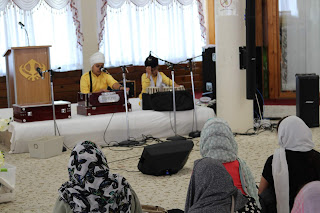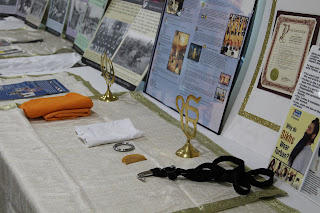Wow! Just wow...what an amazing day of learning! Today we started our day with an overview of religious literacy by listening to some great speakers: Linda Wertheimer, the author of Faith Ed and Benjamin Marcus, from the Religious Freedom Center. They were both so knowledgeable and passionate and imparted some great information; however what I'd really like to focus on in today's post is my learning on Sikhism.
Before today, I'm embarrassed to say I had no real knowledge of Sikhism other than that it originated in India and that Sikh men wear turbans and the women wear head coverings. What I learned today is that Sikhism, the world's fifth largest religion, is quite beautiful.
When we arrived, we were warmly welcomed into their center. After removing our shoes and covering our heads with hair coverings, we were asked to join them for Langar, a shared meal that they prepared for us. We sat on the floor as is their custom, as sitting together at the same level equalizes everyone. They then served us the delicious food that they had prepared for us. After Langar, we moved toward a meeting area where we had an opportunity to listen to Sikh children share a few of their experiences and then were provided an abundance of information on Sikhism. The Sikh's believe that there is only one God. The basic tenets of their faith are that God's name is to be remembered in every breath, that they should earn their living honestly, share their good fortunes with those that are less fortunate, and to engage in selfless service. Additionally, Sikh's believe that all people are equal regardless of their race, gender, religion, or social class. The Sikh's Holy Scripture is known as the Guru Granth Sahib. The Guru Granth Sahib is at the heart of their worship and contains devotional compositions written by Sikh teachers known as "gurus" and hymns which are mainly written in the Punjabi language. The Sikh's believe that the purpose of life is to try to integrate their individual personality with God. The Sikh's religious tenets directly influence their behaviors of serving others and welcoming all as their equals which was evident during Langar and certainly created a sense of belonging.
When we arrived, we were warmly welcomed into their center. After removing our shoes and covering our heads with hair coverings, we were asked to join them for Langar, a shared meal that they prepared for us. We sat on the floor as is their custom, as sitting together at the same level equalizes everyone. They then served us the delicious food that they had prepared for us. After Langar, we moved toward a meeting area where we had an opportunity to listen to Sikh children share a few of their experiences and then were provided an abundance of information on Sikhism. The Sikh's believe that there is only one God. The basic tenets of their faith are that God's name is to be remembered in every breath, that they should earn their living honestly, share their good fortunes with those that are less fortunate, and to engage in selfless service. Additionally, Sikh's believe that all people are equal regardless of their race, gender, religion, or social class. The Sikh's Holy Scripture is known as the Guru Granth Sahib. The Guru Granth Sahib is at the heart of their worship and contains devotional compositions written by Sikh teachers known as "gurus" and hymns which are mainly written in the Punjabi language. The Sikh's believe that the purpose of life is to try to integrate their individual personality with God. The Sikh's religious tenets directly influence their behaviors of serving others and welcoming all as their equals which was evident during Langar and certainly created a sense of belonging.
After the student panel and the presentation was finished, we were welcomed into their Gurdwara, the Sikh place of worship. There the students played an instrument and sang a hymn. During an actual service, worshipers may join in singing the hymns, lead prayer, or just meditate and may come and go as they see fit.
The Sihk's practice the Five K's also known as the Articles of Faith. The articles of faith include: unshorn hair to represent their spirituality, a comb to represent their cleanliness, a steel bracelet, representing their self restraint and connection God, a short sword, to symbolize an emblem of courage, inner strength, and commitment, and lastly a type of underwear knickers to represent their purity of moral character. Additionally, I learned that Sikh men wear turbans and Sikh women wear head coverings to protect their uncut hair and to express themselves outwardly to others as a Sikh. These behaviors create a sense of community with their fellow Sikh's as they illustrate the belief that they are all equal during their worship and their dress.
I am so thankful for the Sikh's who welcomed us into their center and community and shared their beliefs, practices, and customs with us. Thank you!
Becky






No comments:
Post a Comment